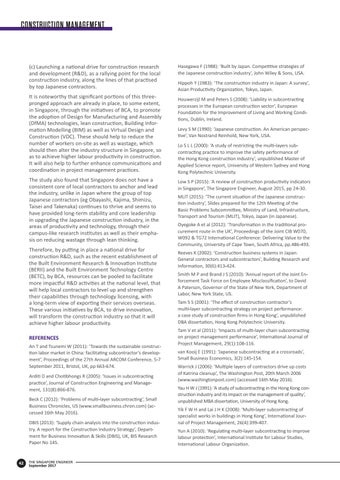CONSTRUCTION MANAGEMENT
(c) Launching a na onal drive for construc on research and development (R&D), as a rallying point for the local construc on industry, along the lines of that prac sed by top Japanese contractors. It is noteworthy that significant por ons of this threepronged approach are already in place, to some extent, in Singapore, through the ini a ves of BCA, to promote the adop on of Design for Manufacturing and Assembly (DfMA) technologies, lean construc on, Building Informa on Modelling (BIM) as well as Virtual Design and Construc on (VDC). These should help to reduce the number of workers on-site as well as wastage, which should then alter the industry structure in Singapore, so as to achieve higher labour produc vity in construc on. It will also help to further enhance communica ons and coordina on in project management prac ces. The study also found that Singapore does not have a consistent core of local contractors to anchor and lead the industry, unlike in Japan where the group of top Japanese contractors (eg Obayashi, Kajima, Shimizu, Taisei and Takenaka) con nues to thrive and seems to have provided long-term stability and core leadership in upgrading the Japanese construc on industry, in the areas of produc vity and technology, through their campus-like research ins tutes as well as their emphasis on reducing wastage through lean thinking. Therefore, by pu ng in place a na onal drive for construc on R&D, such as the recent establishment of the Built Environment Research & Innova on Ins tute (BERII) and the Built Environment Technology Centre (BETC), by BCA, resources can be pooled to facilitate more impac ul R&D ac vi es at the na onal level, that will help local contractors to level up and strengthen their capabili es through technology licensing, with a long-term view of expor ng their services overseas. These various ini a ves by BCA, to drive innova on, will transform the construc on industry so that it will achieve higher labour produc vity. REFERENCES An T and Tsunemi W (2011): ‘Towards the sustainable construcon labor market in China: facilita ng subcontractor’s development’, Proceedings of the 27th Annual ARCOM Conference, 5-7 September 2011, Bristol, UK, pp 663-674. Ardi D and Cho bhongs R (2005): ‘Issues in subcontrac ng prac ce’, Journal of Construc on Engineering and Management, 131(8):866-876. Beck C (2012): ‘Problems of mul -layer subcontrac ng’, Small Business Chronicles, US (www.smallbusiness.chron.com) (accessed 16th May 2016). DBIS (2013): ‘Supply chain analysis into the construc on industry. A report for the Construc on Industry Strategy’, Department for Business Innova on & Skills (DBIS), UK, BIS Research Paper No 145.
42
THE SINGAPORE ENGINEER September 2017
Hasegawa F (1988): ‘Built by Japan. Compe ve strategies of the Japanese construc on industry’, John Wiley & Sons, USA. Hippoh Y (1983): ‘The construc on industry in Japan: A survey’, Asian Produc vity Organiza on, Tokyo, Japan. Houwerzijl M and Peters S (2008): ‘Liability in subcontrac ng processes in the European construc on sector’, European Founda on for the Improvement of Living and Working Condions, Dublin, Ireland. Levy S M (1990): ‘Japanese construc on. An American perspecve’, Van Nostrand Reinhold, New York, USA. Lo S L L (2000): ‘A study of restric ng the mul -layers subcontrac ng prac ce to improve the safety performance of the Hong Kong construc on industry’, unpublished Master of Applied Science report, University of Western Sydney and Hong Kong Polytechnic University. Low S P (2015): ‘A review of construc on produc vity indicators in Singapore’, The Singapore Engineer, August 2015, pp 24-30. MLIT (2015): ‘The current situa on of the Japanese construcon industry’, Slides prepared for the 12th Mee ng of the Basic Problems Subcommi ee, Ministry of Land, Infrastructure, Transport and Tourism (MLIT), Tokyo, Japan (in Japanese). Oyegoke A et al (2012): ‘Transforma on in the tradi onal procurement route in the UK’, Proceedings of the Joint CIB W070, W092 & TG72 Interna onal Conference: Delivering Value to the Community, University of Cape Town, South Africa, pp.486-493. Reeves K (2002): ‘Construc on business systems in Japan: General contractors and subcontractors’, Building Research and Informa on, 30(6):413-424. Smith M P and Brand J S (2010): ‘Annual report of the Joint Enforcement Task Force on Employee Misclassifica on’, to David A Paterson, Governor of the State of New York, Department of Labor, New York State, US. Tam S S (2001): ‘The effect of construc on contractor’s mul -layer subcontrac ng strategy on project performance: a case study of construc on firms in Hong Kong’, unpublished DBA disserta on, Hong Kong Polytechnic University. Tam V et al (2011): ‘Impacts of mul -layer chain subcontrac ng on project management performance’, Interna onal Journal of Project Management, 29(1):108-116. van Kooij E (1991): ‘Japanese subcontrac ng at a crossroads’, Small Business Economics, 3(2):145-154. Warrick J (2006): ‘Mul ple layers of contractors drive up costs of Katrina cleanup’, The Washington Post, 20th March 2006 (www.washingtonpost.com) (accessed 16th May 2016). Yau H W J (1991): ‘A study of subcontrac ng in the Hong Kong construc on industry and its impact on the management of quality’, unpublished MBA disserta on, University of Hong Kong. Yik F W H and Lai J H K (2008): ‘Mul -layer subcontrac ng of specialist works in buildings in Hong Kong’, Interna onal Journal of Project Management, 26(4):399-407. Yun A (2010): ‘Regula ng mul -layer subcontrac ng to improve labour protec on’, Interna onal Ins tute for Labour Studies, Interna onal Labour Organiza on.
